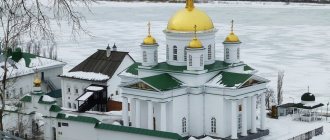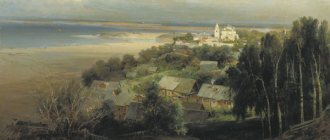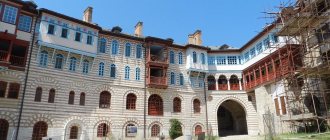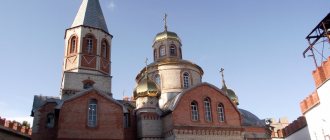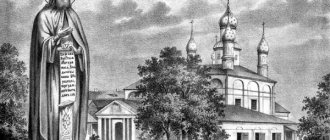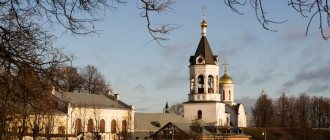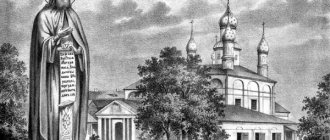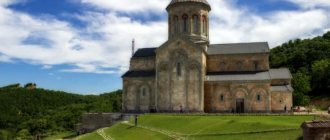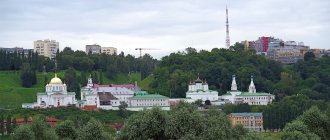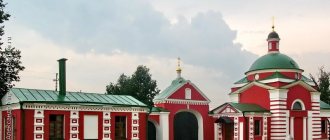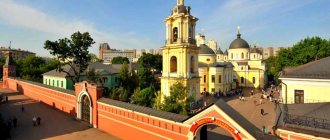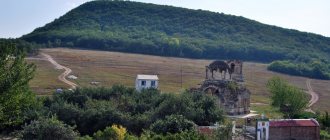Historical reference
Yuryev Monastery (Veliky Novgorod), the founding date of which is 1030, according to legend, was founded by Yaroslav the Wise, who received the name George during baptism, which was pronounced in Russian as “Yuri”.
It is this fact that underlies the name of the monastery. It was first mentioned in chronicles in 1119. For several centuries it was called Lavra and among the monasteries of Veliky Novgorod it was considered the first in importance. In the 15th century he was the richest and largest church feudal lord. In the 20-30s of the 20th century, the monastery was closed and plundered. The Great Patriotic War did not bypass the monastery. Military units of the German and Spanish invaders were stationed here. In the post-war period, the Yuriev Monastery in Veliky Novgorod became a place of residence for people. There was a museum, a technical school, a store, a post office, etc. The monastery was returned to the Russian Orthodox Church in 1991.
Abbots
- Cyriacus (mentioned 1119 - 1128)
- Isaiah (1128 - 1134)
- ? Jonah (c. 1138)
- Dionysius (1158 - 1194)
- Savvaty (1194 - April 16, 1226)
- Savva, Greek (1226 - March 15, 1230)
- Arseny (1230 - ?)
- Varlaam (? - 1270)
- John (1270 - 1274)
- Kirill (1295 - 1310)
- St. Moses (? - 1325)
- Lawrence (mentioned 1333)
- Joseph (1337 - 1345)
- Nikephoros 1352.
- Savva (mentioned 1375, 76; July 1-29, 1377)
- David (1386)
- Parthenius (1398)
- Varlaam (1408; 1410 - 1419)
- Khariton 1420
- Misail 1449.
- Gregory 1460.
- Theodosius 1476.
- Cassian (1499 - December 1504)
- Jonah I (1517 - 1523)
- Silouan (October 2, 1530 - ?)
- Gury (? - September 15, 1539)
- Cassian (? - 1551)
- Hilarion (1551 - 1553)
- Gennady (Mezhov) (1554 - 1558)
- Bartholomew (July 23, 1558 - 1564)
- Leonidas (November 15, 1567 - 1568/1570)
- Theoktist (September 1571 - August 1572)
- Alexander (? - 1576)
- Misail (January 1580 - 1589)
- Joachim (1589 - 1599)
- Nikander (1606 - 1618)
- Dionysius (1618 - 1632)
- Jonah II (1632 - 1633)
- Gerasim (Putnikov/Kunitsa) (January 1634 - 1635)
- Niphon (March 7, 1635 - 1639)
- Hilarion (1640 - 1660)
- Theodosius (1661 - May 23, 1667)
- Parthenius (1666 - 1672)
- Simeon (1672 - 1676)
- Job (6 June 1676 - 1701)
- Sylvester (Kholmsky-Volynets) (1701 - October 23, 1704)
- Gabriel (Dometsky) (December 1704 - August 1708)
- Isaac (August and October 1708)
- Aaron (Eropkin) (December 27, 1708 - 1723)
- Andronik (1723 - 1725)
- Markell (Radyshevsky) (September 27, 1725 - 1726)
- Aaron (Eropkin), 2 times (January 9, 1728 - 1730)
- Andronik, 2 times (January 20, 1731 - September 4, 1734)
- Joseph (Khvabulov) (August 1734 - October 9, 1740)
- Gabriel (Voronov) (October 18, 1740 - January 24, 1741)
- Markell (Radyshevsky), 2 times (January 24, 1741 - 1742)
- St. Pavel (Konyuskevich) (July 23, 1743 - 1758)
- Joasaph (Khotuntsevsky) (May 31, 1758 - April 29, 1759)
- Ioannikiy (Svyatkovsky-Zverev) (May 1, 1759 - June 3, 1768)
- Ioannikiy (Mikritsky) (August 25, 1768 - May 17, 1775) [1]
- Victor (Onisimov) (May 8, 1775 - July 3, 1782)
- Arseny (Buzanovsky) (May 26, 1782 - 1785)
- St. Afanasy (Volkhovsky) (November 13, 1785 - 1788)
- Iriney (Klementyevsky) (June 30, 1788 - 1792)
- Iakinf (Karpinsky) (June 27, 1792 - April 18, 1795)
- Gervasy (Lintsevsky) (May 6, 1795 - 1796)
- Arseny (Todorsky) (June 21 - August 15, 1796)
- John (Ostrovsky) (August 25, 1796 - September 10, 1797)
- Ambrose (Kelembet) (September 17, 1797 - November 13, 1799)
- Mikhail (Desnitsky) (December 6, 1799 - July 20, 1802)
- Ambrose (Protasov) (June 4, 1802 - 1804)
- Parfeniy (Petrov) (January 12, 1804 - 1809)
- Sergius (Krylov-Platonov) (January 27, 1810 - 1811)
- Ambrose (Ornatsky) (1811 - 1812)
- St. Filaret (Drozdov) (March 27, 1812 - March 1816)
- Vladimir (Uzhinsky) (March 10 - May 11, 1819)
- Damascene (Rossov) (May 27 - December 14, 1819)
- Anatoly (Stavitsky) (February 8, 1820 - August 21, 1822)
- Photius (Spassky) (1822 - February 26, 1838)
- Manuil (Soloviev) (May 1, 1838 - February 8, 1857)
- Varlaam (Denisov) (March 22, 1857 - August 21, 1860)
- Geronty (Artyukhovsky) (1860 - 1865)
- Herman (Ossiecki) (March 3, 1866 - 1866)
- Joachim (Pokrovsky) (December 20, 1866 - January 1878 [2])
- Isaiah (Vinogradov) [3] (1878 - March 12, 1896)
- Vladimir (Dobronravov) (March 12, 1896 - June 10, 1905)
- Ioannikiy (Dyachkov) (July 27, 1905 - 1907)
- Joseph (Petrovykh) (1907 - February 27, 1909)
- Anatoly (Junger) (February 27, 1909 - October 23, 1910)
- sschmch. Juvenaly (Maslovsky) (October 23, 1910 - 1914)
- Nikodim (Voskresensky) (August 26, 1914 - 1922)
- Sergius (Vasiliev) (1922 - ?)
- 1929-1991 - closed
- since 1991 - the bishops of Novgorod are the priest-archimandrites
Viceroys
- Theodore (Taraskin) (July 17, 1996 - April 19, 2000)
- Arseniy (Perevalov) (since 2008 - mentioned January 10, 2011) acting
Interesting historical facts
Veliky Novgorod is famous for its rich history. Yuryev Monastery has its own history, which contains many facts that arouse genuine interest among tourists. Let's look at some interesting information:
- The patron of the monastery was Countess Anna Orlova, the daughter of a famous person, Alexei Orlov-Chesmensky. She was an extremely religious woman and donated almost all of her fortune to the needs of the monastery.
- St. George's Monastery in Veliky Novgorod is not distinguished by a large number of monks. In general, they can rarely be found here. This is because there are only four of them. Most often, tourists mistake NDU students for monks.
- On the territory of the monastery there is a large and beautiful apple orchard, which was looked after by students of the NovSU Institute of Agriculture in 1990-2000. Now this is the responsibility of parishioners and pilgrims.
- On the territory of the monastery there is a sign prohibiting smoking. Earlier in 1990, she asked citizens not to walk on the lawn.
- St. George's Cathedral of the Yuriev Monastery (Veliky Novgorod) is the burial place of the mother and elder brother of Alexander Nevsky.
- Right behind the monastery there is “Yuryevsky” beach, where you can swim and sunbathe.
- The Novgorod Theological School is located at the monastery, which began operating in 2004.
Tips for visitors
- Visit the monastery on a guided tour. The guide will tell you a lot of interesting things about this place.
- If you decide to travel by bus, then you need No. 7 or 7-a, which goes from the station. Destination stop – “Yuryevo”.
- If you are traveling by car, exit the city along Troitskaya Street, and then follow the main road until the turn to the monastery.
- When exploring, do not limit yourself to architectural monuments; go around the fortress wall and go down to the river. There is a beautiful view from the shore.
- Be sure to try the local food. The refectory serves delicious lunches, and the monastery shop sells delicious pastries. By the way, on Sundays they feed everyone free of charge.
- Listen to the choir.
- Since you are here, visit the Vitoslavica Museum of Architecture. It is a 10 minute walk from the monastery.
- Excavations and restorations are underway on the territory; be prepared for the fact that some of the buildings may be closed to the public.
- For pilgrims and their children, excursions are conducted by novices of the monastery.
- On the opposite bank of the Volkhov is the Rurik settlement - the trade and military center of Priilmen, the residence of the Novgorod princes. You can look at it using the optics at the gate.
Yuryev Monastery is considered the first Orthodox monastery of the Novgorod land and is included in the UNESCO World Heritage List. This is the only surviving example of an ensemble historical building preserved in the southern outskirts of the city.
The buildings
A whole ensemble of cathedrals and temples makes up the Yuryev Monastery (Veliky Novgorod). A photo of the monastery map hangs at the entrance. Anyone can get acquainted with it. The monastery includes:
- St. George's Cathedral, which is the main temple.
- Holy Cross Cathedral is a beautiful church with blue domes decorated with gold stars.
- Spassky Cathedral.
- The bell tower, which reaches a height of 52 meters, is a visiting card.
- A stone gazebo, where previously there was a consecrated source of water.
- An ancient windmill belongs to the Vitoslavlitsy Museum.
Literature
- Orthodox Russian monasteries: A complete illustrated description of Orthodox Russian monasteries in the Russian Empire and on Mount Athos
, St. Petersburg, Soykin P. P., 1994 (rep. ed. 1910). - Karger, M.K., Novgorod the Great: Architectural Monuments
, Leningrad, Moscow, 1966. - Solovyova, Maria, “Memories of the Yuriev Monastery,” Moscow Church Bulletin
, 1994, No. 10(107), 3. - Muravyov A.N., Novgorod Yuryev Monastery.
Abbots of the monastery (since its restoration under Archimandrite Photius):
St. George's Cathedral
Many churches are located on the territory of the city of Veliky Novgorod. Yuryev Monastery includes several churches.
The main one is St. George's Cathedral. Its construction was initiated in 1119. The church was built by Master Peter. He was one of the first ancient Russian masters, and one of the few whose name has survived to our time. Construction lasted for 11 years. In 1130 it was consecrated in the name of St. George the Victorious. The abbots of the monastery, some Russian princes and Novgorod mayors are buried here.
The style of the cathedral is impeccably logical. Its forms have material weight. It’s as if he was created for a princely exit, and not at all for a transition to contemplation and self-deepening. This reflects the character of the temple and its purpose. After all, it was originally built not only as the main cathedral of the monastery, but also as a princely church.
The exterior of the cathedral and the interior decoration are grandiose. However, it is distinguished by a large number of monotonous niches and windows, which are arranged in belts. Despite this grandeur, the architecture of the cathedral is simple. It is lined with stone blocks and bricks. The roof has four slopes. Previously, it was covered with lead sheets and was distinguished by its originality. Three chapters, arranged asymmetrically, form the crown of the temple.
The walls of the cathedral were painted shortly before the consecration. But, unfortunately, at present the ancient fresco painting is almost completely destroyed. Only minor fragments remain that decorate the window slopes, as well as ornamental decorations. But the ancient painting was preserved in a small temple, which is located in a tower in the northwestern side.
The cathedral amazes with its power and grandeur. Since the walls of the church are very thick, it is always cold there. However, it works. According to the monastery charter, divine services are held here. The brethren are still small, but gradually the cathedral is being revived, the temple is being repaired, icons are being painted, and the monastic economy is being organized.
Holy Cross Cathedral
St. George's Monastery (Veliky Novgorod) includes another temple - the Cathedral of the Exaltation of the Cross.
This is a beautiful church with blue domes decorated with golden stars. This cathedral is immediately noticeable against the background of the general ensemble of the monastery. It is located right in the wall and immediately attracts attention against the background of the other white walls. There are five blue chapters. There are 208 eight-pointed stars on them. Previously, there was a wooden church in its place, which burned down in 1823.
After the Bolsheviks closed the temple, it lost its beautiful wall paintings. Now it's just painted white.
The temple has a heating system, so services are regularly held here at any time of the year.
Spassky Cathedral
On the northwestern side of the St. George Church is the Spassky Cathedral. Initially, a church was built on this site from A. Nevsky stone. However, in 1823 there was a strong fire here that destroyed it. The following year, the Spassky Cathedral was erected in the same place, based on the foundations of the old church. It was ordered by Archimandrite Photius. It was rebuilt with money donated to the monastery by Anna Orlova. The Church of the Praise of the Virgin Mary was organized in the basement. It became the tomb for Archimandrite Photius and benefactor Anna Orlova.
In 1929, the temple along with the tombs was looted, and the remains of Photius and Anna were stolen. Later they were found in Arkazhi in the Annunciation Church.
The Great Patriotic War caused serious damage to the cathedral. All the heads of the church were destroyed, but were restored in the post-war period. Now the cathedral is operating again.
Description
The white walls of the monastery are visible far above the blue waters of the Volkhov River, and Lake Ilmen lies nearby. Even today, when the Yuryev Monastery complex has not been completely repaired or restored, its buildings still look grandiose. On the territory of the monastery there are several buildings and a large bell tower. Most of the buildings are decorated in the classicist style and represent traditional Russian churches.
St. George's Cathedral
It became the central cathedral of the entire monastery, and its construction began in 1119 on the initiative of Prince Mstislav I and under the leadership of the master of that time, Peter. According to legend, the construction of the Church of the Annunciation, as well as the St. Nicholas Cathedral, belonged to the hand of the master. The Church of St. George was built over the course of 11 years and was consecrated only in the summer of 1130. Since it was the largest building on the territory of the monastery, the cathedral became a necropolis for Novgorod nobles and Russian princes.
St. George's Cathedral of the Yuryev Monastery
In the 1820s, the cathedral was restored, but its frescoes dating back to the 12th century were damaged - they were only partially preserved. During the restoration, the cathedral was redecorated. In 1902, the renovated building was consecrated again.
With the advent of the Bolsheviks and Soviet power, services in the cathedral were stopped; it was severely damaged by military actions and was restored only in 1951–1952. Today, restoration work continues, although religious services are already being actively held.
Holy Cross Cathedral
The construction of the new cathedral took place under the leadership of Archimandrite Photius and was truly large-scale. The new cathedral had white traditional walls outside and inside, and bright blue domes with stars. The head of the temple can be seen from afar, but upon closer inspection it becomes clear that they were decorated with love. There are a total of 208 eight-pointed stars on the chapters.
With the advent of Soviet power, the building was first designated as a museum, then a post office and a warehouse. In the early 90s, there was a gallery of local master painters here. Only in 19991 did the building return to the leadership of the Russian Orthodox Church and large-scale reconstruction began - in 2004, the wooden frames were replaced by metal ones, the cladding of the domes was updated, and the heating system was adjusted. Today, services are held in the cathedral every Sunday.
Spassky Cathedral
The first church, which later became the Spassky Cathedral, was erected in 1763 by order of Archimandrite Ioannikis I. However, 60 years later there was a severe fire that completely destroyed the structure. On the foundation of the burned building, the Spassky Cathedral was erected by order of the same Archimandrite Photius.
Spassky Cathedral of the Yuryev Monastery
The temple has four chapels, which were completed over the course of 100 years, and a porch, which was also built much later than the main building (only in 1830). Nevertheless, the general style of the building was preserved, and today it looks majestically as an integral complex, which was facilitated by repeated restorations. a porch was added to the building, and in 1836 the Church of the Praise of the Virgin Mary was located on the ground floor. It was in it that the bodies of Photius and benefactress Anna Orlova-Chesmenskaya were buried.
Under Soviet rule, the building was not used for its intended purpose and was somewhat dismantled - its domes and drums were dismantled so that they would not overshadow the main church of the monastery, St. George's Cathedral. The building was seriously damaged in 1941-1945 and was partially restored in the 1950s. Only after the cathedral was returned to the Russian Orthodox Church were the domes rebuilt and the temple began to have its former majestic appearance.
Small buildings
On the territory, the bell tower attracts attention - it dates back to 1841 and has 4 tiers and a height of 52 m. Its parts differ noticeably in parameters - according to legend, Nicholas I personally made changes to the finished project so that the final building would not be taller or better than the bell tower in the Kremlin. At the top of the bell tower there was previously a clock with 17 bells that chimed the time. The largest of them weighed 33.6 tons - it was the Burning Bush bell. Today, at its top there are not only domes, but also a mobile phone tower.
The two churches on the territory of the monastery were not built separately, but became part of larger buildings. One of them is the Church of the Burning Bush Icon of the Mother of God. It was laid down as a request to God to protect the monastery from fires, since it was from fire that it completely burned down several times. The church was founded in 1828, but it can only be entered from the South Building.
Attention! Today, services are held there for residents and on holidays. Tourists cannot visit these premises on their own.
The second temple is the Church of the Archangel Michael, which is located in the tower on the southeastern part of the wall. The tower was erected as part of the fence in 1760, and the church was built there in 1831. Restoration here first took place in 2010-2013.
Shrines and holidays
Special solemn services are held 4 times a year, with the exception of the great Christian holidays - Christmas, Epiphany and Easter. The patronal feast days of the monastery fall on the following dates:
St. George the Victorious - Memorial Day on May 6. Exaltation - September 27. Memorial Day of the image of the "Burning Bush" - September 17. Memorial Day of Michael the Archangel - September 19 and November 21.
Interior of St. George's Cathedral
Pilgrims can come on one of the holidays to attend the solemn service. But even on ordinary days in the monastery you can join the shrines that are kept there:
Icon of St. George and the Virgin Mary "Burning Bush". Relics of the Hieromartyr Theoktist of Novgorod and Princess Theodosia of Vladimir. Shroud of D. Shemyaki, embroidered in gold.
Before the revolution, the monastery kept a piece of rock on which a noble maiden was chained - it was she who was saved by the Great Martyr George. There, in the sacristy, a precious dish was also preserved, a gift from Prince Vsevolod-Gabriel. But after the revolution, these shrines were lost or stolen.
On a note! On the territory there is a large necropolis in which many noble people of Novgorod are buried. Among them is Anna Alekseevna Orlova-Chesmenskaya, a countess who acted as the patroness of the monastery.
Bell tower
Against the background of all the buildings of the Yuryev Monastery, the bell tower stands out for its height. It consists of 4 tiers. Its height is 52 meters. It was built in 1838-1841. The bell tower was designed by Carlo Rossi. The construction was carried out by the architect Sokolov. If you look at the bell tower directly, you can notice the disproportion of its parts. This is due to the fact that Nicholas the First deleted the middle tier from the project so that the building would not be higher than the bell tower of Ivan the Great in the Kremlin. During Easter week, any tourist can try ringing the bells. This building is clearly visible from a pedestrian bridge in a city like Veliky Novgorod. Yuriev Monastery is easy to distinguish from a distance. The bell tower with a golden dome that literally glows in the sun is the hallmark of the monastery.
